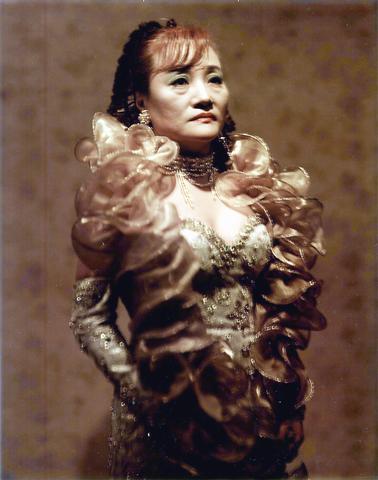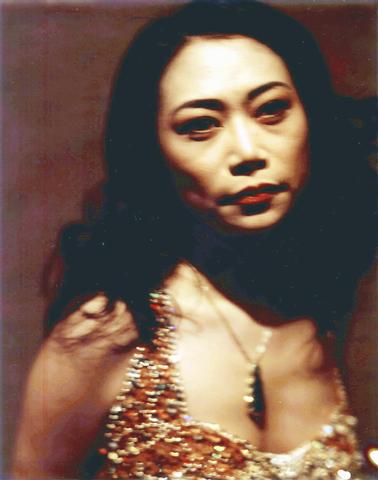Looking behind the curtain, seeing what isn't out on show, has both cachet and appeal. It is also, by definition, difficult and sometimes dangerous. Jeff Hargrove's second Taipei show, which brings his artist's eye to bear on the women who sing at Taipei's red packet cabarets, looks behind the curtain on a number of different levels, and is one of the most interesting photographic exhibitions with a local focus to be shown in some time. The last occasion was probably Chang Chien-chi's (
Jeff Hargrove, a Paris-based artist, has already done one show in Taipei. On that occasion, it was a series of portraits of Taiwanese artists. The stakes have gone up since then, and in turning his eye to the shadow world of Taipei's entertainment district, Hargrove has taken up a considerably tougher challenge. While most artists are hungry for publicity and relatively media savvy, the women who sing in Taipei's red packet cabarets are distinctly camera shy.

PHOTNS COURTESY OF JEFF HARGROVE
Most distinctively, in tackling this secret world, Hargrove totally rejected the hole-in-the-wall surreptitious photography that miniaturized technology has made possible. He does not want to steal images from a hostile environment. In opting to shoot with a 4x5 Deardoff, Hargrove cast aside any pretense of secrecy.

"We became friends," Hargrove said. "When we went in, everyone would come over an talk with us. We weren't like regular clients. They didn't feel they needed to put on their charms for us."
According to Serina Yeh (

The cabarets are seen alternatively as places where old men go for solace and as pits of iniquity in which singing serves only as a front for thinly disguised prostitution. In the complex social environment of the old city, the truth, as you might expect, is a good deal more complex.
"Many of the singers have very interesting, very difficult life stories," said Hargrove, who sees these women as shouldering enormous social pressures simply in order to carry on with their lives.
This situation was put in particular perspective by an article in the Chinese-language China Times last week that almost led to the cancellation of the show, which suggested that the singers of the red packet cabarets were simply "withered old women building fantasies for withered old men." While these are no Britney Spears or Christina Aguilera -- some may even be described as matronly -- Hargrove seeks a beauty that goes beyond skin deep. The strength, sorrow, pride and vulnerability that he has managed to capture in the portrait series can be very moving, and each time you look at them, new depths are revealed.
His style of work, the commitment of time and emotional energy that it requires, goes a long way to explaining what he has achieved. Regarding the many months of preparatory work, Yeh said that it was essential to establish the high level of trust that the photos required. "We hadn't thought [the preparatory period] would be so long," she said. "We had to judge when the time was right to raise the matter of taking the photos. We had to be very sensitive to their feelings."
But the investment, artistically speaking, has paid off handsomely, and Hargrove is well aware of the dividends he has reaped from "working together" with his subjects. "I wanted to show their most intimate feelings," he said.
To warm the singers up to the portrait shot, Hargrove had them sing the song they felt most deeply about -- many of these the common currency of Chinese love songs. "But for many of these women, there is a reason why they choose a certain song," Hargrove said. "I asked them to focus on this feeling when I took the shot."
This was a conscious exercise in self-revelation and Hargrove said that the most moving aspect of this project was the willingness of these women to bare their souls to the camera. "I asked them to sing, because this always raised the level of emotion," Hargrove said. And often, even with the presence of a large-format camera, the photo shoots become powerfully emotional moments for both the subject and the photographer.
The photos themselves, taken on 8x10 Polaroid stock, has a surreal quality that Hargrove said was the reason for giving up his favored black and white stock.
"These singers are a man's dream," he pointed out. "The red packet cabaret has a fantasy quality for the men who visit there." The visual quality of the photographs enhance this, with its over-saturated colors and eerily soft focus, that these women, in the eyes of most who see them, for all their possible imperfections, have an untouchable, ethereal, and eminently nostalgic quality.
His individual style didn't make him an instant hit with the singers he photographed, but a thoughtful approach to his photos reveals the rightness of the path he has chosen.
"Maybe it is not the best photo that has been taken of them," Hargrove said, emphasizing "in their eyes." Certainly, these are not photos of a conventional beauty. But ultimately, these are not conventional portraits. They tell stories of strength in the face of divorce, death, debt, and in the end, a world changed out of all recognition for a generation brought up to expect something completely different.
One aspect of the series that should not be ignored is that these women all work in the same environment -- in this case, the same red packet cabaret. Here lies the big difference with Hargrove's previous work. "The artists I photographed before, they were all very much individuals. These women are all part of a single place, so it is a communal portrait of a special world."
Whatever the negative stereotyping of the world these women live in, and the women themselves, the effect of Hargrove's images is a tonic against prejudice. Even in the trite words of a love song, the powerful spirit of womanhood comes through -- a will to live, a desire to survive, a care for the tawdry trappings that make us human. These portraits of the disenfranchised are powerful images of the complex social environment that is Taiwan.

That US assistance was a model for Taiwan’s spectacular development success was early recognized by policymakers and analysts. In a report to the US Congress for the fiscal year 1962, former President John F. Kennedy noted Taiwan’s “rapid economic growth,” was “producing a substantial net gain in living.” Kennedy had a stake in Taiwan’s achievements and the US’ official development assistance (ODA) in general: In September 1961, his entreaty to make the 1960s a “decade of development,” and an accompanying proposal for dedicated legislation to this end, had been formalized by congressional passage of the Foreign Assistance Act. Two

March 31 to April 6 On May 13, 1950, National Taiwan University Hospital otolaryngologist Su You-peng (蘇友鵬) was summoned to the director’s office. He thought someone had complained about him practicing the violin at night, but when he entered the room, he knew something was terribly wrong. He saw several burly men who appeared to be government secret agents, and three other resident doctors: internist Hsu Chiang (許強), dermatologist Hu Pao-chen (胡寶珍) and ophthalmologist Hu Hsin-lin (胡鑫麟). They were handcuffed, herded onto two jeeps and taken to the Secrecy Bureau (保密局) for questioning. Su was still in his doctor’s robes at

Last week the Democratic Progressive Party (DPP) said that the budget cuts voted for by the China-aligned parties in the legislature, are intended to force the DPP to hike electricity rates. The public would then blame it for the rate hike. It’s fairly clear that the first part of that is correct. Slashing the budget of state-run Taiwan Power Co (Taipower, 台電) is a move intended to cause discontent with the DPP when electricity rates go up. Taipower’s debt, NT$422.9 billion (US$12.78 billion), is one of the numerous permanent crises created by the nation’s construction-industrial state and the developmentalist mentality it

Experts say that the devastating earthquake in Myanmar on Friday was likely the strongest to hit the country in decades, with disaster modeling suggesting thousands could be dead. Automatic assessments from the US Geological Survey (USGS) said the shallow 7.7-magnitude quake northwest of the central Myanmar city of Sagaing triggered a red alert for shaking-related fatalities and economic losses. “High casualties and extensive damage are probable and the disaster is likely widespread,” it said, locating the epicentre near the central Myanmar city of Mandalay, home to more than a million people. Myanmar’s ruling junta said on Saturday morning that the number killed had